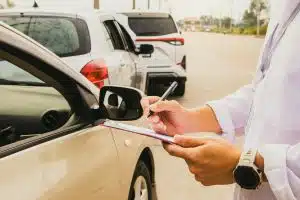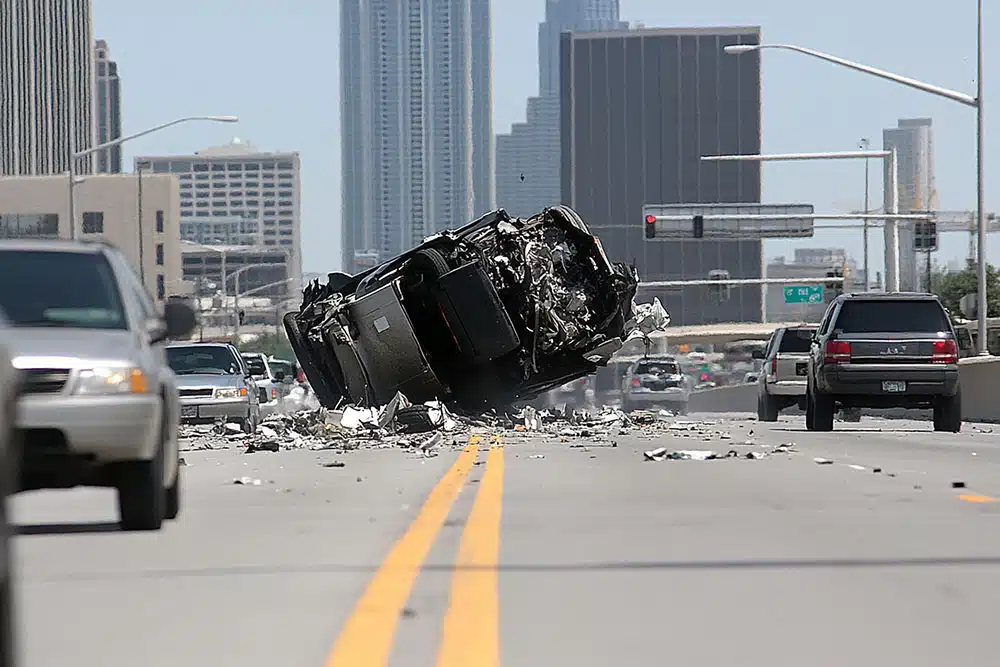When it comes to three-car accidents, who’s at fault and who pays for damages are the two most important questions to answer. The at-fault party is typically responsible for paying damages, but sometimes, it’s not easy to determine who caused the crash and who’s liable for any injuries or losses that result.
If you were recently in a three-car accident, you may already know this all too well. You need to understand how to determine who’s at fault for the crash, and more importantly, how insurance companies and courts make this determination. You also need to know what you can do to limit your liability and improve your chances of getting the maximum compensation you deserve.
Reach out to an experienced New York City car accident attorney near you right away for a free consultation. They can review your case and advise you of your rights and options. They can also advocate for you if another driver’s insurance company tries to blame you for the accident and fight for your rights and future.
New York City Car Accident Guide
- Common Types of 3-Car Accidents
- Determining Fault in 3-Car Accidents
- Potential Liability Scenarios in 3-Car Crashes
- State Laws and Their Impact on Multi-Car Accident Claims
- Who Pays for Damages in a 3-Car Crash?
- Steps to Take After a 3-Car Accident
- Why You Need Legal Representation After a 3-Car Accident
- Get Help from an Experienced Car Accident Lawyer Today
Common Types of 3-Car Accidents
Multi-vehicle crashes come in all shapes and sizes, but there are a few scenarios we see more often than others. Understanding these can help you make sense of what happened in your own accident.
- Rear-end chain reactions: Imagine that you’re stopped at a red light when suddenly, you feel a jolt from behind. The force of the impact pushes your car into the vehicle in front of you. This domino effect is a classic example of a rear-end chain reaction.
These accidents often happen when one driver isn’t paying attention or is following too closely. In most cases, the driver at the back bears primary fault for the collision. Maybe they were checking their phone or fiddling with the radio. Whatever the case, they set off a chain reaction that leaves you and others injured.
- T-bone collisions: T-bone accidents usually occur at intersections when one driver fails to yield the right of way. In a three-car scenario, the initial impact might push one vehicle into a third, creating a cascade of damage. Determining fault here often involves analyzing traffic signals, witness statements, and the points of impact on each vehicle.
These crashes can be especially dangerous because the sides of vehicles offer less protection than the front or rear. The potential for serious injury is high, making it all the more important to seek proper legal representation if you’ve been involved in one.
- Multi-lane accidents: These complex crashes typically happen on highways or multi-lane roads. They might start with a side-swipe between two vehicles, causing one to veer into another lane and collide with a third car.
These accidents can be particularly tricky when it comes to determining fault, as there may be multiple contributing factors and responsible parties.
Determining Fault in 3-Car Accidents
When it comes to figuring out who’s responsible for a three-car pileup, insurance companies and personal injury attorneys conduct thorough investigations and carefully analyze the evidence to determine fault. Various factors come into play during the process:
General Principles of Fault Determination
At its core, determining fault in any car accident comes down to figuring out who was negligent. In legal terms, negligence means failing to act with reasonable care. On the road, this could mean anything from texting while driving to running a red light or failing to yield the right of way.
In a three-car accident, investigators will look at each driver’s actions leading up to the crash. They’ll consider things like:
- Who had the right of way?
- Were any traffic laws broken?
- Was anyone driving recklessly or distracted?
- Were road conditions a factor?
- Did any vehicles have mechanical failures?
By piecing together these details, they can start to paint a picture of who bears responsibility for the accident.
Role of Police Reports and Witness Statements
When the police arrive at an accident scene, they’ll create an official report. This document can be incredibly valuable when it comes to determining fault. It will include details about the accident scene, statements from the drivers involved, and sometimes the officer’s opinion on who was at fault.
Witness statements can also play a crucial role. Bystanders who saw the accident happen can provide an unbiased account of events. Their perspectives can help fill in gaps and corroborate (or contradict) the statements of those involved in the crash.
Importance of Physical Evidence and Accident Reconstruction
Sometimes, the scene of the accident itself holds the key to determining fault. Skid marks on the road, the position of the vehicles after the crash, and damage patterns on the cars can all provide valuable clues.
In more complex cases, accident reconstruction experts might be called in. These specialists use advanced techniques to analyze the evidence and create a detailed picture of how the accident unfolded. They can determine things like vehicle speeds, points of impact, and the sequence of events leading up to the crash.
All of this information comes together to help insurance companies, lawyers, and potentially a court determine who was at fault for the accident.
Potential Liability Scenarios in 3-Car Crashes
Three-car accidents can result in various liability outcomes. These include:
- Single driver at fault: In some cases, one driver’s actions are clearly responsible for the entire accident. For example, if a distracted driver rear-ends a stopped car with enough force to push it into a third vehicle, that initial driver may bear full liability for all resulting damages.
- Shared fault between two drivers: It’s not uncommon for two drivers to share responsibility. Consider a scenario where one driver changes lanes without signaling, causing another to swerve and hit a third car. Both the lane-changing driver and the swerving driver might be found partially at fault.
- All three drivers sharing some degree of fault: In complex situations, all three drivers might bear some responsibility. This could occur if one driver was speeding, another failed to signal a turn, and the third was following too closely. In such cases, determining the percentage of fault for each party becomes crucial for insurance and legal purposes.
State Laws and Their Impact on Multi-Car Accident Claims
The location of your accident can significantly influence how fault is assigned and compensation is awarded. Different states follow different legal doctrines:
- Comparative negligence states: Many states follow a comparative negligence rule, which allows injured parties to recover damages even if they’re partially at fault. However, their compensation is reduced by their percentage of fault. Some states use a “pure” comparative negligence system, while others follow a “modified” approach that bars recovery if a party is more than 50% at fault.
- Contributory negligence states: A handful of states still adhere to the stricter contributory negligence rule. In these jurisdictions, if you’re found even 1% at fault for the accident, you may be barred from recovering any compensation. This underscores the importance of working with an attorney to build a strong case to prove the other parties’ liability.
- No-fault insurance states: In no-fault states, each driver’s own insurance covers their medical expenses and lost wages, regardless of who caused the accident. However, serious injuries that meet certain thresholds may still allow for claims against at-fault parties.
Also, each state has its own legal deadlines for filing car accident lawsuits in court. The deadline for filing a personal injury lawsuit in New York, for instance, is three years from the date of the accident. In New Jersey, it’s only two years. If you miss the deadline for filing, the court will likely bar you from recovering damages.
You must consult an attorney as soon as possible after the crash to learn of any deadlines that apply to your case so you don’t lose your right to obtain compensation.
Who Pays for Damages in a 3-Car Crash?
After a three-car accident, one of the biggest questions on everyone’s mind is: who’s going to pay for damages? The answer isn’t always straightforward, but understanding the basics can help you navigate this tricky situation.
- Insurance companies: In most cases, the at-fault drivers’ insurance companies are responsible for covering damages. However, when multiple parties share fault, insurers may dispute their level of responsibility, leading to prolonged negotiations or even litigation.
- Personal injury claims and lawsuits: You should never try to handle your claim by yourself. Most likely, the insurance company will offer you a settlement well below what you are really entitled to receive. Therefore, you should always consult an attorney to try to settle your case for you or file a personal injury lawsuit against the at-fault parties. This legal action can help you recover damages for medical expenses, lost wages, pain and suffering, and other accident-related costs.
- Uninsured/underinsured motorist coverage: If one or more at-fault drivers lack sufficient insurance, your own uninsured/underinsured motorist coverage can be a crucial safety net. This coverage can help fill the gap when responsible parties can’t fully compensate you for your losses.
Steps to Take After a 3-Car Accident
What you do following a three-car accident can significantly affect your ability to recover damages. Important steps to take include
- Check yourself and others for injuries, and call 911 immediately. Even if injuries seem minor, it’s crucial to have police and medical professionals at the scene.
- Take photos of the accident scene, including vehicle positions, damage, and any visible injuries. This visual evidence can be invaluable later on.
- Collect names, contact information, insurance details, and license plate numbers from all drivers involved. Be factual in your conversations, but avoid admitting fault or apologizing, as these statements could be used against you later.
- Contact a car accident attorney. They can protect your rights and guide you through the claims process. They can also advocate for you and improve your chances of getting the most from your car accident claim.
- Notify your insurance company about the accident as soon as possible. Provide them with the basic facts, but avoid giving recorded statements or accepting quick settlement offers without legal advice.
Why You Need Legal Representation After a 3-Car Accident
Having an attorney represent you after a three-car accident offers several benefits:
- Three-car accidents involve intricate legal and factual issues. An experienced attorney can navigate these complexities, ensuring that all responsible parties are held accountable.
- Dealing with multiple insurers requires skill, legal knowledge, and persistence. Your lawyer can handle all communications with insurers and negotiate for a fair settlement on your behalf. A lawyer can protect your interests and ensure the insurance company doesn’t take advantage of you by offering a lowball settlement.
- A skilled attorney knows how to properly value your claim. They’ll consider not just current medical bills but also future expenses, lost earning capacity, and non-economic damages like pain and suffering.
Get Help from an Experienced Car Accident Lawyer Today
With more than 50 years of experience handling car accident claims in New York, New Jersey, and Pennsylvania, the Rothenberg Law Firm LLP is here to guide you through the claims process and fight for the compensation and justice you deserve.
Our dedicated attorneys understand what you’re going through, and we know how to handle cases effectively. To date, we’ve recovered billions of dollars in settlements and verdicts for our clients and will do all we can to maximize your financial recovery.
Don’t risk losing out on compensation because another driver’s insurance company blames you for the crash. You can rely on us to thoroughly investigate the incident and work to establish fault on the rightful parties.
Contact our New York City personal injury lawyers today to request a free consultation with one of our compassionate car accident attorneys. We work on a contingency fee basis, so you pay nothing upfront for us to represent you. We only get paid attorney fees if we secure compensation for you. Under this arrangement, you don’t have to worry about how to pay for a lawyer when you’re already experiencing financial hardships. Let us put our skills and resources to work for you to help you get the full and fair compensation you need.






